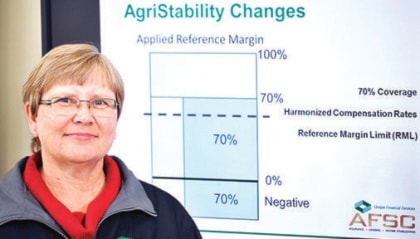With just weeks remaining for Ponoka County farmers to enrol in AgriStability for 2013, many producers across the province are asking how upcoming changes to the program will impact their farms.
“Some farmers are asking if it’s still worthwhile to participate in the program because they say, ‘Commodity prices are high and times have been good on my farm, so I haven’t collected a payout for a few years. Why do I need AgriStability?” said Vicki Chapman, with Agriculture Financial Services Corporation (AFSC). AFSC administers AgriStability on behalf of the federal and provincial governments.
“I remind farmers that all it takes is one catastrophic event – such as a livestock disease like BSE or a sudden economic downturn – and the profitability many are now enjoying can turn on a dime,” said Randy Jensen, an AFSC AgriStability field analyst in the central Alberta region.
“The producers I’ve been talking to haven’t forgotten those big events, so they get the importance of having a backstop like AgriStability to compensate them for major losses on their farm. That’s where the program continues to offer the most value.”
April 30 enrolment deadline
Jensen has been meeting one-on-one with area farmers and holding AgriStability information sessions across the region. “It’s my job to ensure farmers understand the new program changes and the risk level it still covers on their farm – so they can make an informed decision before the April 30 enrolment deadline passes. The worst scenario would be if someone opts out of the program without having a clear understanding of what they’re saying no to, and then experiences a disaster that threatens the financial future of their farm,” he explained.
The federal-provincial AgriStability program will continue providing whole farm protection against severe drops in farm income caused by factors such as production losses, falling commodity prices, rising input costs and market interruptions, says Jensen. However, coverage is now being reduced in some areas and expanded in others.
Coverage reduced in some areas, expanded in others
“Beginning in 2013, producers must experience a larger drop in farm income before triggering payments under AgriStability,” he explained, noting the changes will not affect 2012 AgriStability claims.
“Payouts under the new rules will now trigger when a producer’s margin – their allowable income minus allowable expenses – drops below 70 per cent of either their ‘Olympic’ margin over the last five years or their average allowable expenses during that time frame, whichever is lower,” Jensen said. He explains Olympic margins are calculated by dropping the highest and lowest margins over the last five years and averaging the remaining three.
“The trigger point for payments was previously at 85 per cent,” said Jensen. “Limiting coverage to a producer’s average allowable expenses when it’s lower than their Olympic margin is also new.”
Once payments trigger, producers will be paid 70 cents for every dollar of loss. They were previously paid up to 80 cents on losses above a zero margin, and only 60 cents on losses below a zero margin – known as a negative margin, Jensen said.
“Now if farmers suffer a big hit and drop into a negative margin – where they typically can no longer cover their input costs – they’ll receive a bigger payment at that 70 cent level. The changes provide more money where losses are deepest and transfer some of what’s considered ‘normal’ business risk back to producers,” he explained.
The changes to AgriStability are driven by higher crop and livestock prices over the last few years, which have made producers more profitable, said Chapman. “Greater profitability means many have built significant margins under the program that have increased the liability to government at a time of budget restraint.”
Greater profitability drives changes
“If the payment trigger had remained at 85 per cent, those higher margins could easily trigger claims to producers who are still profitable – just a little less profitable,” added Chapman. “AgriStability is meant to help farmers when they’re hurting, not when they’re making money.”
Chris Simpson, who runs a 200-head cow-calf operation near Rimbey, understands the rationale behind the AgriStability changes and plans to sign up again this year.
“It’s the only form of production insurance available for my livestock. On the crop side, I have crop and forage insurance. On the livestock side, I can manage some of my price risk with CPIP (the Cattle Price Insurance Program). But if I have a calving wreck or a scour outbreak, AgriStability is the only risk management I have that covers production losses. To me, that’s where it plays a key role.”
Field Staff and myAFSC make paperwork easier
Farmers who view paperwork as an obstacle to participating in AgriStability can contact their local field analyst for help in completing the forms, said Jensen. “We can sit down and guide them through the process.”
Producers with questions about AgriStability should contact a field analyst at their AFSC District Office, visit www.afsc.ca, or phone the AFSC Call Centre at 1-877-899-AFSC (2372) before the April 30 deadline.
— SUBMITTED
